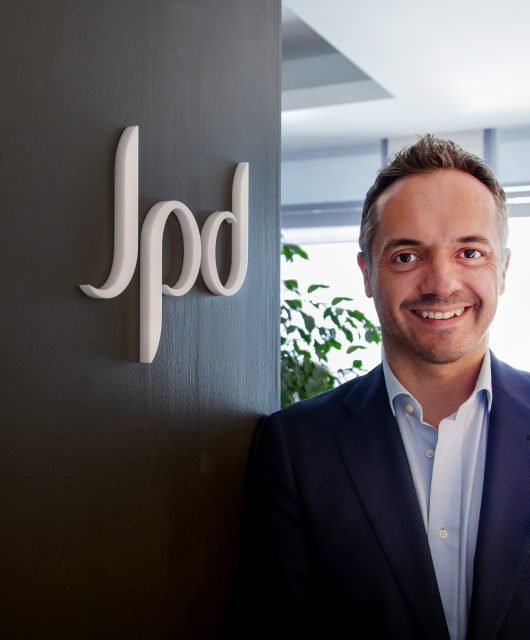The Brandberries approached Graham Hitchmough, CEO Asia Pacific of Brand Union, for a Q&A around the controversial topic “Is de-branding the future of branding?”. To our surprise, Graham did the unexpected! He brilliantly steered us away from an interview to take us on what we can call a ‘BrandStorming” journey. With a visually captivating intro, to a compelling and mind challenging narrative, Graham was able to provoke our thoughts and shift mindsets. Without further ado, we leave you with Graham’s insights.
“Soon after accepting the kind invitation to contribute some thoughts on ‘De-branding’ to this publication, I found myself in a setting that I thought would provide the perfect stimulus for canvassing some views on the topic. How wrong I was.
Allow me to explain. I was in Singapore, where earlier in the day Brand Union and our sister agency FITCH had successfully launched the local edition of the Group XP Experience Index (of which more later). My regional management team and I were keen to celebrate over a nice dinner and, led emphatically by our network’s visiting Chief Growth Officer, we decided to eschew the many gilded celebrity chef haunts that pepper Singapore in favour of an unprepossessing – but known to locals – Chinese joint located next to a car park in a well-worn housing estate. There was no air-conditioning and we sat on red plastic chairs idly perusing laminated menus before ordering what we knew, from experience, to be house specials.
As we sat, satisfied, having been plied with memorably great food, a plentiful supply of Chinese tea and bill that barely nudged S$150 for five people, I spied the perfect opportunity to broach the topic of de-branding. Surely, I reasoned, ensconced as we were in this virtual temple to ‘de-branding’, the same colleagues who had held forth so volubly that morning to assorted CMOs, CEOs and CFOs on the commercial impact of brand experience would have some firm views on de-branding as both concept and strategy. But no. There was no light of recognition in their eyes, no “aha moment” of having touched upon a hot-button topic. Instead they stared blankly back at me, even after I shared my own understanding of the term and conversation eventually turned in more fruitful directions.
Although hardly enlightening as an exchange, this anecdote rather sums up my considered thoughts on de-branding. It doesn’t really exist. It’s a chimera. A construct. An affectation. When you try to grasp at it as an intellectual or practical concept, it dissipates like tendrils of smoke. Or perhaps that should be hot air. De-branding is yet another of those marketing buzzwords given illegitimate credence by being polemical – equally useful as a weapon of choice to those that seek to debunk and devalue brand impact, and many brand practitioners themselves, over-zealously keen to seize upon anything that might demonstrate that they are still in control and have another winning card up their sleeves to play in the ever-changing, obscurantist game of modern marketing.
Not convinced? Let’s examine the ‘evidence’ as it was presented to me as context for writing this piece:
BB: Advertising is losing its impact and brands are on a constant look for new ways to win customers over.
 GH: Well let’s for a start elevate the conversation beyond the narrowing realm of ‘advertising’ to embrace all branded (and even un-branded) communications. Yes, of course ‘branding’ people are constantly seeking new ways to acquire and retain consumers, just as all commercially-driven entities must try to pre-empt and adapt to changing market needs. New branding and marketing techniques are perpetually coming to the fore and having their moment in the sun as they tessellate neatly with prevailing consumer habits and technological advancements. But this doesn’t inevitably presage a wholesale abandonment of tried and trusted techniques. The 60-second TV spot may no longer be the fetishistic media planning tent-pole that it once was, and must now rub shoulders with the less romantic, more mechanical, algorithmic world of programmatic and digital marketing, and the stealthy smoke and mirrors of branded and native content, but try telling the likes of Airbnb, Apple and Anheuser-Busch Inbev that ‘appointment advertising’ is dead and that their contribution to the US$15bn-worth of Superbowl LI’s media spend was misplaced in the context of their wider brand and marketing strategies.
GH: Well let’s for a start elevate the conversation beyond the narrowing realm of ‘advertising’ to embrace all branded (and even un-branded) communications. Yes, of course ‘branding’ people are constantly seeking new ways to acquire and retain consumers, just as all commercially-driven entities must try to pre-empt and adapt to changing market needs. New branding and marketing techniques are perpetually coming to the fore and having their moment in the sun as they tessellate neatly with prevailing consumer habits and technological advancements. But this doesn’t inevitably presage a wholesale abandonment of tried and trusted techniques. The 60-second TV spot may no longer be the fetishistic media planning tent-pole that it once was, and must now rub shoulders with the less romantic, more mechanical, algorithmic world of programmatic and digital marketing, and the stealthy smoke and mirrors of branded and native content, but try telling the likes of Airbnb, Apple and Anheuser-Busch Inbev that ‘appointment advertising’ is dead and that their contribution to the US$15bn-worth of Superbowl LI’s media spend was misplaced in the context of their wider brand and marketing strategies.
The truth is that brands are not by definition losing their impact, but rather mutating and adapting to the market’s changing dynamics as they have always done. A coherent portfolio approach to brand-building is every bit as vital to communicators today as a coherent portfolio strategy has been to manufacturers for decades. That’s progress and that’s why I’m writing this piece for an online publication rather than a printed one.
BB: Branding (sic) people have been making brands perceived by their customers as if they’re living in an imaginary world, instead of communicating a product’s intrinsic qualities.
GH: Really? Have decades of branding brilliance really gone into creating fanciful fantasy worlds fundamentally disconnected to the products that they seek to promote? Certainly egregious missteps like the one taken recently by Pepsi demonstrate all too clearly how brands (or at least their representatives) can lose both the product and the plot in an all-consuming quest for ‘eyeballs’, the crassness of which can take the breath away. But by the same token, brands such as Nike and Apple (yes, obvious examples but for good reason) have always and continue to fuse product integrity with emotional aspiration. For every one of Nike’s multi-million thematic brand campaigns there are countless product innovations, iterations, launches, grass-roots activations and tactical messages. And what more beautifully simple (and simply beautiful) evocation can there be of the fusion of art and science, function and form than Apple’s ‘Shot on iPhone…’ global outdoor campaign.
So, let’s by all means rub marketers faces in it when they really allow the product and the brand to disastrously decouple, but let’s also remember that the very essence and raison d’etre of branding is to carry product and purpose powerfully into the consumer’s consciousness – the extrinsic and the intrinsic, intertwined and elevated.
BB: Should businesses put the product or the brand first and should companies prioritize investing in branding and branded content or having well-made products?
GH: There is no doubt that product (or service) must come first and must be developed with research and rigour either to fulfill an existing identified consumer need or, as is increasingly the case with disruptive development models, to create an entirely new one. But it is as fallacious to assert that the relationship between intrinsic product quality and extrinsic brand communication is a binary one, as it is to suggest that a shift from investing in branding and marketing to product development “will allow more people to buy pure, simple, quality products at process that reflect real value and not the conceptual value that branding magnifies.”
It’s time to put to rest the idea that brand investment is an unnecessary overhead for businesses and their customers. Building upon the data from Millward Brown’s BrandZ report (the most extensive consumer research programme in the world), the recent Group XP Experience Index demonstrates that products which deliver consistently strong brand experience are 26% more likely to drive sustained consumer demand, while at the same time increasing overall brand value by 166% and outperforming average stock market growth by over 200%. Moreover, consumers gravitate to compellingly articulated, carefully nurtured brands not because they are weak-willed and powerless, but because they are confronted everyday by unparalleled choice and complexity and if a product can satisfy both their functional needs and emotional impulses as well as suit their pocket, then why shouldn’t their selection be informed by every possible piece of information at their disposal?
It’s amusing that various experts (and Wikipedia) cite the examples of Nike and Starbucks dropping the corporate name from their brand identities and Coca-Cola’s hugely successful ‘Share a Coke – Names’ campaign as evidence of an advancing de-branding trend, when in fact if anything, all three represent the apotheosis of successful brand husbandry over many decades. None of these examples conform to a self-fulfilling narrative of branding’s declining influence, but rather support the story of strong brand’s implacable ability to adapt to changing environments and contexts. The Nike and Starbucks brand evolutions are not de-branding stories at all, or even ‘de-corporatisation’ stories. They are demonstrations of how a brand’s visual assets when endowed with real meaning and applied over many years with care and expertise can assume new levels of efficiency and adaptability, without diluting what they represent. I have some sympathy with those that would say that these qualities are deployed at least in part to further propel the incursion of globalised brands into every culture and onto every street, but this doesn’t support a thesis that brands are having to roll back or deconstruct their brands to be accepted. It shows that they are established and resilient enough to carry as much emotional resonance in a reduced version of their public face as they are in the whole. Just as each cell of a living being carries the same genetic code, each component of a well-constructed brand should carry the same, unwavering DNA.
And in the case of Coca-Cola? A cute idea and a brilliant and insightfully conceived tactical marketing campaign that has stretched seamlessly across geographies. But a sign of the unstoppable encroachment of de-branding? Give me a break!
It’s telling that any proposed examples of de-branding tend to exist in the FMCG or retail F&B space where competition is at its most intense and brands inveterately need to adapt to complex portfolio strategies and wildly disparate retail environments. In this hard fought arena, it is survival of the fittest and if that sometimes means playing somewhat fast and loose with established brand equities, then that is an acceptable price of ongoing success. But only in very few cases of highly commoditised retail segments can it be contended that some form of genuine de-branding really does exist, and even then it is highly questionable. Outside the special case of own-label brands, there are still some manufacturers in FMCG and in pharma that pursue a generics strategy that is largely predicated on demonstrating parity in quality and satisfaction without the ‘extraneous’ and costly elements of branding and communications. But even in these isolated examples the success of the offer is not automatically ensured by an attractive product-price proposition. Intense marketing efforts are still required even to get products listed and merchandised and word-of mouth then needed to build the customer base – word of mouth which is rarely left to work on its own without some form of monitoring and encouragement. The ‘generic-isation’ of such product segments and now, in particular, the tobacco category also show us that there is a [grey] art to bringing generic product propositions to market that relies every bit as much on an acute understanding of a brand’s underlying purpose and principles as does a half-time spot in the Superbowl.
De-branding then is emphatically, absolutely, demonstrably not the future of branding. It is barely a blip on the radar and only of interest to those that either want to promulgate the story of branding’s inevitable decline, or the opposing school that wants to convince everyone (and themselves) of just how exceedingly clever we branding and marketing people are. Branding, when executed and managed well, is a wonderfully adaptive, reflexive and responsive discipline and is at its most powerful and transformative when it rises above the arcane, internecine debates about methodology to focus on its innate usefulness and demonstrate its genuine commercial and experiential impact. The evidence is out there and we, as practitioners, need to stop getting in our own way and instead focus on finding better, more measurable and meaningfully ways connect with brand owners, purveyors and consumers.





